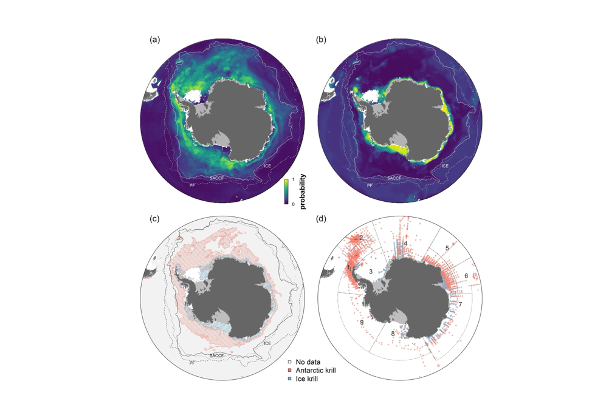
Figure 2 from the paper: Habitat suitability estimates for (a) Antarctic krill (E. superba) and (b) Ice krill (E. crystallorophias). (c) Comparison of estimated habitat based on species-specific HSMs using 0.40 and 0.46 as binary cut-off maximizing the area under the receiver operating characteristic curve (AUC) for Antarctic krill and Ice krill, respectively. The PF, SACCF, and >10 d with sea ice coverage each year (ICE) are illustrated in (a–c) as stippled, solid black, and dotted lines, respectively (Park et al., 2019). (d) Observational data distribution (presences and absences) for the two species used to model species-specific HSM, including CCAMLR MPA Planning Domains 1–9.
Research on the distribution of Antarctic krill and Ice krill in the Southern Ocean has shown distinct habitats between the two species. The study, “Quantifying circumpolar summer habitat for Antarctic krill and Ice krill, two key species of the Antarctic marine ecosystem”, published in the journal ICES Journal of Marine Science, was conducted by Benjamin Merkel (Akvaplan-niva As, Fram Centre, Tromsø, Norway) and colleagues.
The abstract follows:
“Antarctic krill (Euphausia superba) and Ice krill (Euphausia crystallorophias) are key species within Southern Ocean marine ecosystems. Given their importance in regional food webs, coupled with the uncertain impacts of climate change, the on-going recovery of krill-eating marine mammals, and the expanding commercial fishery for Antarctic krill, there is an increasing need to improve current estimates of their circumpolar habitat distribution. Here, we provide an estimate of the austral summer circumpolar habitat distribution of both species using an ensemble of habitat models and updated environmental covariates. Our models were able to resolve the segregated habitats of both species. We find that extensive potential habitat for Antarctic krill is mainly situated in the open ocean and concentrated in the Atlantic sector of the Southern Ocean, while Ice krill habitat was concentrated more evenly around the continent, largely over the continental shelf. Ice krill habitat was mainly predicted by surface oxygen concentration and water column temperature, while Antarctic krill was additionally characterized by mixed layer depth, distance to the continental shelf edge, and surface salinity. Our results further improve understanding about these key species, helping inform sustainable circumpolar management practices.”
Reference:
Merkel, B., Trathan, P., Thorpe, S., Murphy, E.J., Pehlke, H., Teschke, K. and Griffith, G.P. Quantifying circumpolar summer habitat for Antarctic krill and Ice krill, two key species of the Antarctic marine ecosystem, ICES Journal of Marine Science, Volume 80, Issue 6, August 2023, Pages 1773–1786, https://doi.org/10.1093/icesjms/fsad110
23 October 2023

 Français
Français  English
English  Español
Español